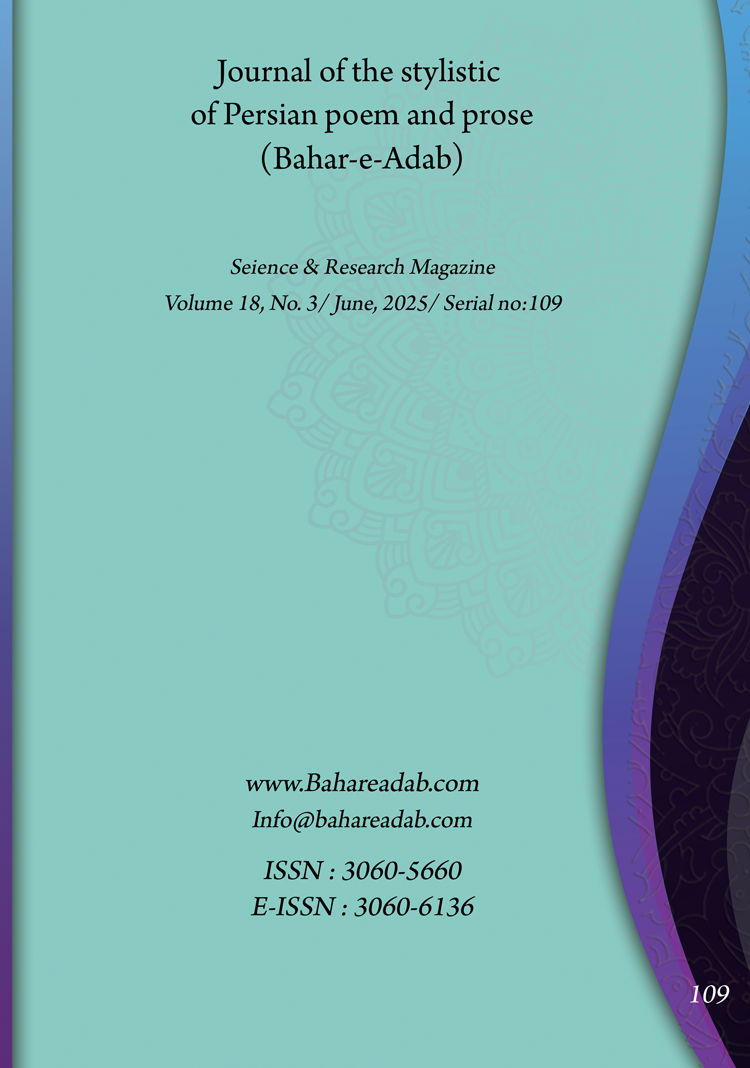- Count View : 115
- آدرس کوتاه شده مقاله: https://bahareadab.com/article_id/1830
- کد doi مقاله: Doi: 10.22034/bahareadab.2025 .18 .7819
Journal of the stylistic of Persian poem and prose
volume Number 18،
number In Volume 3،
،
issue Number 109
An ideal woman in lyrical and mystical literature (The study of Khamsa of Nizami and Molavi Masnavi)
Roqiyeh Habibi , Reza Forsati Joybari (Author in Charge), Nahid Akbari
Abstract
BACKGROUND AND OBJECTIVES: In this article, by selecting two prominent works: Nizami Ganjavi"s Panj Ganj from lyrical literature and Mowlavi"s Masnavi Manavi from mystical literature, the position of the ideal woman and her characteristics have been investigated with the aim of analyzing the personality of ideal women and expressing the differences and similarities in lyrical and mystical literature.
METHODOLOGY: Data collection is through library study and the article is written in a descriptive-analytical manner. The statistical population is the two works of Nezami Ganjavi"s Panj Ganj and the six books of Mowlavi"s Masnavi Manavi.
FINDINGS: In lyrical and Mowlavi"s poetic systems, in the stories of Masnavi, in fictional characters, Nizami Ganjavi has named women who have superior characteristics compared to other women in general and they are called ideal women in the term. These women are in the position of the transcendent lover, king and ruler of the city in lyrical literature and in the position of the transcendent lover, queen of the city, wife, mistress and mother who have become mystics, seekers of the path of love and symbols of truth in symbolic interpretation in mystical literature. Beauty, modesty, loyalty, wisdom, political acumen, and good behavior are the characteristics of these women. In terms of differences and similarities, appearance and beauty are not considered in mystical literature, and they are not the main criteria for an ideal woman in lyrical literature, and they are accompanied by the characteristics of loyalty, modesty, and acumen. Moral characteristics are common to both, but ideal women have a mystical character in mystical literature that is not in lyrical literature, although transcendent love can be interpreted mystically, such as the character of Leyli, who has entered mystical literature through symbolic interpretation from lyrical literature.
CONCLUSION: Despite the criticism of women, which is part of the content of literature, women are described as having external, moral, and transcendent and mystical characteristics in individual and social life in lyrical and mystical literature, who are in the position of ideal women. These women have a high social position, and examples of these are the characters of Shirin, Leyli, Mahin Banu, Noshabeh, and Mariah Qobtiyeh in Nizami Ganjavi Panj Ganj and the characters of Leyli, Hazrat Maryam, Bilqis, the mother of Hazrat Musa, and Asiyeh, the wife of Pharaoh in mystical literature.
Keyword
Ideal woman
, Lyrical literature
, Mystical literature
, Nizami Ganjavi
, Mowlavi's Masnavi
- Aghahosseini, Hossein (2010). “Comparing Khosrow and Shirin of Shahab Tarshizi with Khosrow and Shirin of Nezami”, Persian Language and Literature Research Journal, Year 2, No. 8. pp. 21-36.
- Estalami, Mohammad (2005) The Masnavi of Rumi Jalal al-Din Mohammad Balkhi, Introduction, Correction, Commentaries, 7 volumes, Tehran: Sokhan.
- Barati, Mohammad Reza (2009) The Magic of Speech (Review and Analysis of the Character of Bahram in Haft Peykar Nezami), Mashhad: Ahang Qalam.
- Barry, Michael (2006) Michael Barry’s Commentary on Haft Peykar Nezami, Translated by Jalal Alavinia, Tehran: Nei
- Tajdini, Ali (2015) The Culture of Symbols and Signs in Molana’s Thought, Tehran: Soroush.
- Saghafi, Zuleikha (2002). The Manifestation of Women in Molawi’s Works, Tehran: Tarfand.
- Hosseini, Maryam (2008) “A Comparative Study of the Image of Women in the Works of Khaqani and Nezami”, Journal of the Faculty of Literature and Humanities, Shahid Bahonar University of Kerman, New Volume, No. 23, Serial 20, pp. 89-110.
- Zarrinkoob, Abdolhossein (1985) The secret of Nei (Analytical and Comparative Criticism and Explanation of the Masnavi), 2 volumes, Tehran: Elmi Farhangi.
- Obqari, Nahid (2014) Explanation of Masnavi Manavi; With a Comparative Look at the Fundamentals of Theoretical Mysticism, 6 volumes, Mashhad: Bang Nei.
- Modaresi, Fatemeh, Saba, Forough, Keshtkar, Tayyebeh (2014) “A Study of the Position of Women in the Works of Mehdi Shojaei Based on the Short Stories of Santamaria”, Specialized Monthly Journal of Persian Poetry and Prose Stylistics (Bahar Adab), Year 7, No. 3, pp. 219-234.
- Momayzi, Fatemeh and Bahmani Motlagh, Yadollah (2013) “The Ladder of the Woman’s Ascent in Nezami’s Khamseh” Women and Culture Magazine, Year 5, Issue 18, pp. 25-40.
- Molana, Jalal al-Din Mohammad (2018) Masnavi Manavi, edited by Mohammad Ali Movahed, Tehran: Hermes.
- Naderi, Tohid, Moharmi, Ramin and Mokhtari, Masrooreh (2018) “Intertextual Relations between Mowlavi's Masnavi Manavi and Nezami Ganjavi's Masnavi Based on Gerard Genette’s Transtextual Theory”, Persian Language Studies, Vol. 5: pp. 108-136
- Nezami Ganjavi, Elias bin Yousef (2008) Nezami’s Khamse, based on Moscow edition, Baku, Tehran: Hermes.
- Noormohammadi, Roqiyeh; Farzad, Abdolhossein (2018). "Comparison of allegorical characters in the Masnavi of Jalal and Jamal by Nazlabadi and Leyli and Majnun by Nezami", Quarterly Journal of Allegorical Research in Persian Language and Literature, Bushehr Branch, No. 35: pp. 90-109.

